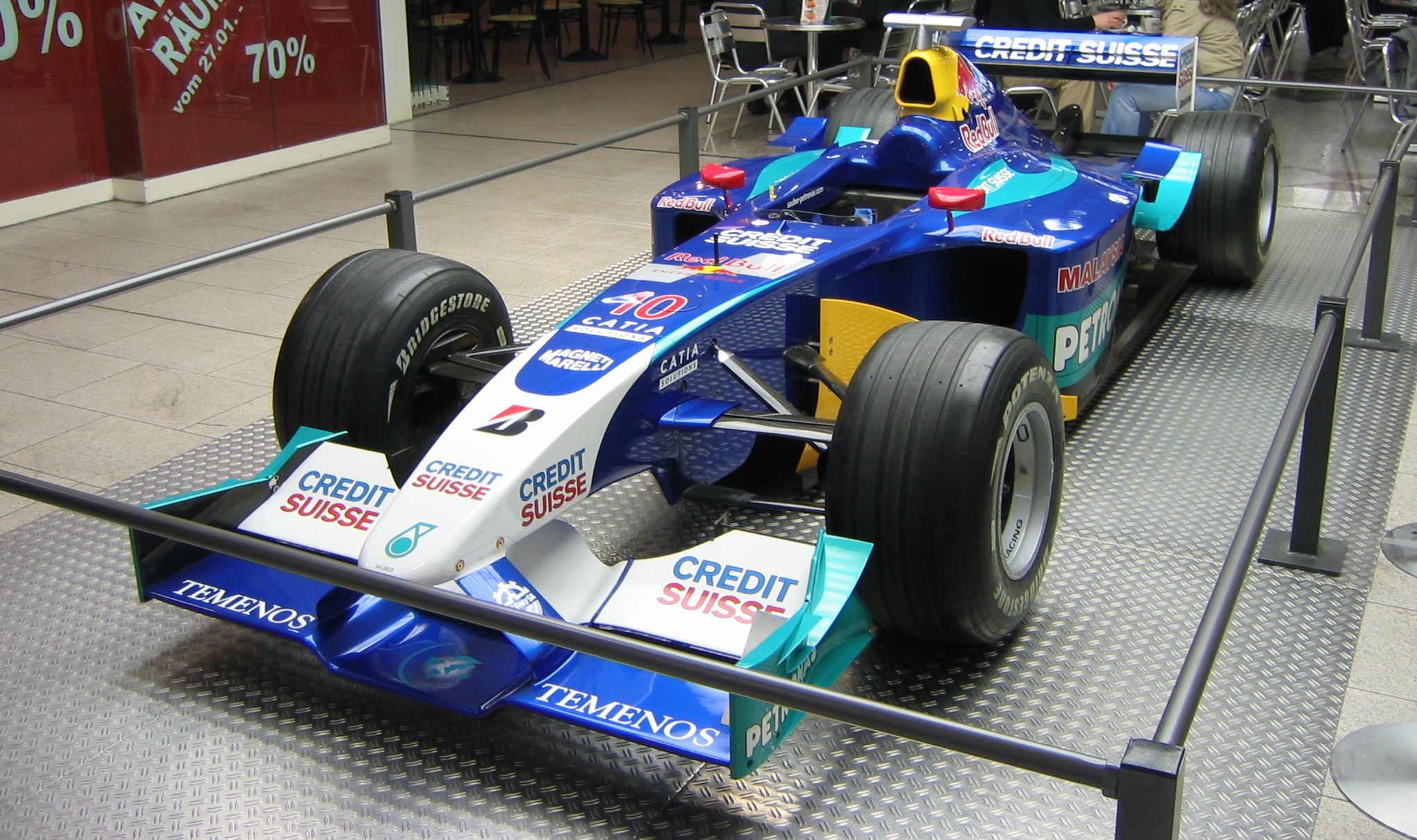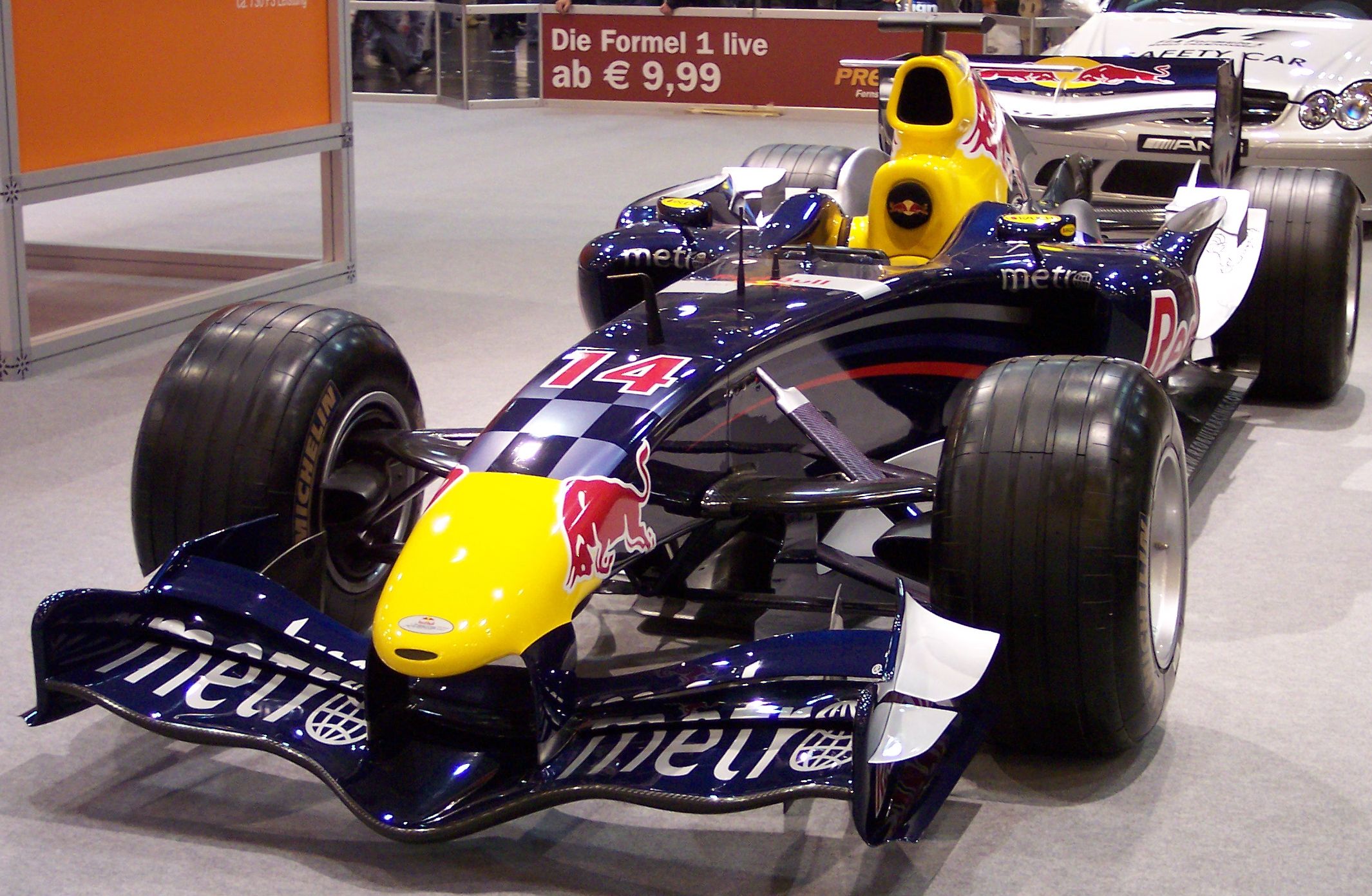Suspension keel on:
[Wikipedia]
[Google]
[Amazon]
A suspension keel is an extension pylon to the bodywork of single-seat,  :Single-keel: Perhaps the simplest response, utilising a single, planar extension to the
:Single-keel: Perhaps the simplest response, utilising a single, planar extension to the  :Twin-keel: As the name suggests, rather than one single keel, two shorter keel stubs are used. Each protrudes from the underside or lower corners of the nose cone, and the left and right suspension arms are mounted to the appropriate keel. This design reduces the disturbance to the airflow, but compromises the suspension set up and configuration flexibility, and introduces significant structural complexity and weight. The twin-keel concept was conceived by Harvey Postlethwaite during his time at Honda Racing Developments, before being introduced by
:Twin-keel: As the name suggests, rather than one single keel, two shorter keel stubs are used. Each protrudes from the underside or lower corners of the nose cone, and the left and right suspension arms are mounted to the appropriate keel. This design reduces the disturbance to the airflow, but compromises the suspension set up and configuration flexibility, and introduces significant structural complexity and weight. The twin-keel concept was conceived by Harvey Postlethwaite during his time at Honda Racing Developments, before being introduced by  :V-keel: Used principally by the
:V-keel: Used principally by the  One limitation of any keel design is that, while the keel influence may vary, the suspension linkages themselves still disrupt the underbody airflow. This problem was exacerbated when the FIA introduced rule changes in that forced teams to mount their front wing in a more elevated position. In response to this, many F1 teams have developed zero-keel chassis designs. Here the keel is removed entirely, and the suspension is mounted directly to the chassis. As the nose cone is in a raised position, this entails that the suspension arms take a distinctly inclined angle with respect to the road surface, reducing suspension efficiency. However, with continued restrictions to aerodynamic
One limitation of any keel design is that, while the keel influence may vary, the suspension linkages themselves still disrupt the underbody airflow. This problem was exacerbated when the FIA introduced rule changes in that forced teams to mount their front wing in a more elevated position. In response to this, many F1 teams have developed zero-keel chassis designs. Here the keel is removed entirely, and the suspension is mounted directly to the chassis. As the nose cone is in a raised position, this entails that the suspension arms take a distinctly inclined angle with respect to the road surface, reducing suspension efficiency. However, with continued restrictions to aerodynamic
Craig Scarborough's technical information site: www.scarbsF1.com
NASA: Aerodynamics in Car Racing
{{Webarchive, url=https://web.archive.org/web/20091206034447/http://www.nas.nasa.gov/About/Education/Racecar/ , date=6 December 2009 Aerodynamics Motorsport terminology Automotive suspension technologies
open wheel
An open-wheel car is a car with the wheels outside the car's main body, and usually having only one seat. Open-wheel cars contrast with street cars, sports cars, stock cars, and touring cars, which have their wheels below the body or inside fend ...
racing cars
Auto racing (also known as car racing, motor racing, or automobile racing) is a motorsport involving the racing of automobiles for competition. In North America, the term is commonly used to describe all forms of automobile sport including n ...
designed with a raised nose cone
A nose cone is the conically shaped forwardmost section of a rocket, guided missile or aircraft, designed to modulate oncoming fluid dynamics, airflow behaviors and minimize aerodynamic drag. Nose cones are also designed for submerged wat ...
, to allow the lower suspension arms to be attached to the car approximately parallel to the road surface. In recent years the placing and design of a suspension keel, or the lack of such, has been one of the few distinct variables in Formula One
Formula One (F1) is the highest class of worldwide racing for open-wheel single-seater formula Auto racing, racing cars sanctioned by the Fédération Internationale de l'Automobile (FIA). The FIA Formula One World Championship has been one ...
chassis design.
Traditional low nose cone designs (e.g. the McLaren MP4/4) allow the lower suspension arms to be directly attached to the main structural members of the car. However, since the move to high nose cone designs – which allow better use of airflow underneath the car, and to a lesser extent the front wing
is a Japanese visual novel studio known for the production of adult ''bishōjo games''. Its main office is located in Taitō, Tokyo. The representative producer and president is Ryūichirō Yamakawa. “Frontwing” is the company's main brand ...
– location of these lower arms has proven problematic. For ideal suspension geometry, and hence maximum mechanical grip, the lower arms should be long and near parallel with the road. As there is no longer any structural bodywork in these low positions, extensions were developed to allow the suspension to be mounted with correct geometry. Since the advent of high nose designs in the early 1990s, pioneered on the Tyrrell 019
The Tyrrell 019 was a 1990 Formula One racing car, designed by a team led by Harvey Postlethwaite, and built by Tyrrell Racing, Tyrrell. It was an evolution of Postlethwaite's first design for Tyrrell, the Tyrrell 018.
The car was introduced two ...
Formula One car, three major keel designs have emerged to solve this problem:
 :Single-keel: Perhaps the simplest response, utilising a single, planar extension to the
:Single-keel: Perhaps the simplest response, utilising a single, planar extension to the ventral
Standard anatomical terms of location are used to describe unambiguously the anatomy of humans and other animals. The terms, typically derived from Latin or Greek roots, describe something in its standard anatomical position. This position prov ...
surface of the car's nose cone, providing a plate onto which the proximal
Standard anatomical terms of location are used to describe unambiguously the anatomy of humans and other animals. The terms, typically derived from Latin or Greek roots, describe something in its standard anatomical position. This position prov ...
ends of the suspension arms can be mounted. Benefits include a simple construction design, and the flexibility of having a large surface, thus allowing the suspension geometry to be altered for fine tuning. A serious hindrance in the single-keel design is that the keel itself protrudes into the underbody airflow, thus reducing the benefits of the raised nose design. As a consequence of this the single keel design fell out of favour in the late 2000s. However, for the 2010 Formula One season both the Mercedes MGP W01 and Virgin VR-01
The Virgin VR-01 was a Formula One motor racing car designed by Nick Wirth for Virgin Racing in the season. It was driven by former Toyota Racing (Formula One team), Toyota driver Timo Glock and Brazilian ex-2009 GP2 Series season, GP2 driver Lu ...
feature single keel front suspension.
 :Twin-keel: As the name suggests, rather than one single keel, two shorter keel stubs are used. Each protrudes from the underside or lower corners of the nose cone, and the left and right suspension arms are mounted to the appropriate keel. This design reduces the disturbance to the airflow, but compromises the suspension set up and configuration flexibility, and introduces significant structural complexity and weight. The twin-keel concept was conceived by Harvey Postlethwaite during his time at Honda Racing Developments, before being introduced by
:Twin-keel: As the name suggests, rather than one single keel, two shorter keel stubs are used. Each protrudes from the underside or lower corners of the nose cone, and the left and right suspension arms are mounted to the appropriate keel. This design reduces the disturbance to the airflow, but compromises the suspension set up and configuration flexibility, and introduces significant structural complexity and weight. The twin-keel concept was conceived by Harvey Postlethwaite during his time at Honda Racing Developments, before being introduced by Sauber
Sauber Motorsport AG, currently competing in Formula One as Stake F1 Team Kick Sauber, and also known simply as Kick Sauber or Sauber, is a Swiss motorsport engineering company. It was founded in 1970 (as PP Sauber AG) by Peter Sauber, who pro ...
during the 2000 Formula One season and swiftly copied by many other teams. In , only Red Bull Racing
Red Bull Racing, currently competing as Oracle Red Bull Racing and also known simply as Red Bull or RBR, is a Formula One racing team, List of Formula One constructors#Team's nationality, competing under an Austrian racing licence and based in ...
used a twin-keel chassis.
 :V-keel: Used principally by the
:V-keel: Used principally by the Renault F1
Renault, a French automobile manufacturer, has been associated with Formula One as both team owner and engine manufacturer for various periods since 1977. In 1977, the company entered Formula One as a constructor, introducing the turbo engine ...
team, who introduced the design in , this variant uses two keel elements protruding downward in a V shape. The tips of the elements are fused, and at this point the suspension arms are mounted. Something of a compromise position, benefits include a reduction in disturbance to the underbody airflow in comparison to a single-keel design, with fewer geometry restrictions than with twin-keels.
 One limitation of any keel design is that, while the keel influence may vary, the suspension linkages themselves still disrupt the underbody airflow. This problem was exacerbated when the FIA introduced rule changes in that forced teams to mount their front wing in a more elevated position. In response to this, many F1 teams have developed zero-keel chassis designs. Here the keel is removed entirely, and the suspension is mounted directly to the chassis. As the nose cone is in a raised position, this entails that the suspension arms take a distinctly inclined angle with respect to the road surface, reducing suspension efficiency. However, with continued restrictions to aerodynamic
One limitation of any keel design is that, while the keel influence may vary, the suspension linkages themselves still disrupt the underbody airflow. This problem was exacerbated when the FIA introduced rule changes in that forced teams to mount their front wing in a more elevated position. In response to this, many F1 teams have developed zero-keel chassis designs. Here the keel is removed entirely, and the suspension is mounted directly to the chassis. As the nose cone is in a raised position, this entails that the suspension arms take a distinctly inclined angle with respect to the road surface, reducing suspension efficiency. However, with continued restrictions to aerodynamic downforce
Downforce is a downwards lift force created by the aerodynamic features of a vehicle. If the vehicle is a car, the purpose of downforce is to allow the car to travel faster by increasing the vertical force on the tires, thus creating more gri ...
through the use of aerofoil
An airfoil (American English) or aerofoil (British English) is a streamlined body that is capable of generating significantly more lift than drag. Wings, sails and propeller blades are examples of airfoils. Foils of similar function designed ...
wings, and the lighter V8 engines specified from 2006 onwards causing weight distribution to shift forward, many designers apparently consider this drawback to be less significant than the concomitant increase in venturi downforce generated underneath the car; except for Renault and Red Bull, all of the teams in the 2007 Formula One World Championship used a zero-keel design.
References
External links
Craig Scarborough's technical information site: www.scarbsF1.com
NASA: Aerodynamics in Car Racing
{{Webarchive, url=https://web.archive.org/web/20091206034447/http://www.nas.nasa.gov/About/Education/Racecar/ , date=6 December 2009 Aerodynamics Motorsport terminology Automotive suspension technologies